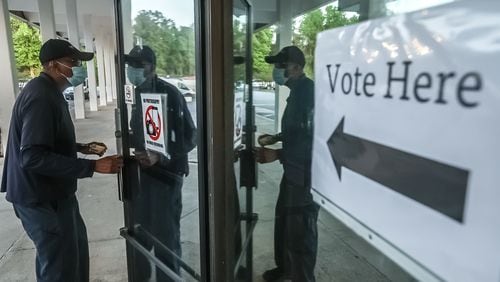Five years ago, after Brian Nichols shot up the Fulton County Courthouse and killed three people there, authorities vowed to aggressively address security shortcomings.
Committees were formed. Meetings were held. And money was spent, at first.
“It’s certainly safer but could it be better? Yeah,” said U.S. Marshal Richard Mecum, who headed a commission on courthouse security set up weeks after Nichols murdered four people – three of them at the Fulton County Courthouse -- on March 11, 2005.
Mecum said funding is needed and there is still much to overcome in changing attitudes and practices of the people who work there.
Lt. Col. Jimmy Carter, who oversees courthouse security for the Fulton Sheriff’s Office, said there is no money now to make many improvements while at the same time the agency’s staff, like the rest of county government, is short and stretched.
Another thing in short supply is the political will that came with the outrage after Nichols severely beat a 52-year-old deputy in a holding cell and used her gun to murder Judge Rowland Barnes, court stenographer Julie Ann Brandau, deputy Sgt. Hoyt Teasley and, later that day, off-duty federal agent David Wilhelm at his home.
“I’m bothered that we haven’t got the financial support that the citizens of Fulton County deserve, that our deputies deserve,” Carter said. “There are things that require expenses, those [projects] have not moved … quickly.”
Carter added that he could not explain why the changes weren’t made years ago – when the shootings were fresh memories and when the county’s finances were better -- because another sheriff and administration were in place.
But for almost five years, a security plan, which may not necessarily have a cost, had not been implemented. State law requires sheriffs in every county to develop a courthouse security plan but the senior judges for those courthouses must approve them.
Judge Cynthia Wright, who is chair of the court’s security committee, said a Fulton County plan was approved only a couple of months ago. “Unfortunately, it has not been implemented to its fullest,” she said. “Part of the problem is funding.
“We are concerned there are 80 unfilled positions in the Sheriff’s Office,” Wright said.
That has meant deputies rotate between posts at the courthouse and the jail, the sheriff’s other responsibility, so the expertise in courthouse procedures is limited.
Also, Wright said, many times there is only one deputy assigned to a courtroom even though “ideally” every judge should have two.
Out of sight to the public is the place that was the first critical failing that Friday morning five years ago -- the tiny control room where deputies watch more than 50, mostly tiny, monitors as their images jerk from scene to scene around the courthouse.
The Fulton County Courthouse Commission said much would improve just by simply making physical changes in the control room. At the moment Nichols attacked deputy Cynthia Hall in a holding cell, there was only one deputy watching the monitors.
Just having a bigger space would allow for a better layout, the commission said.
At the very least, a window to a hallway should be obstructed to eliminate distractions coming from outside.
“I’m not happy,” Carter said of the control room and the technology used there.
Wright said the judges are trying to find grants and other money sources to pay for the control room renovation.
At the same time, the recommended cameras and motion sensors were not put in the stairwells, like the one Nichols used to make his escape.
Cameras were installed outside the courthouse but they are limited and not all are working as they should. Carter said he is also dissatisfied with the camera systems used in courtrooms in adjoining buildings. .
“They aren’t offering us the views we would like,” Carter said.
Staffing problems also now mean two of three entrances to the courthouse complex are now closed to the public at 9 a.m., the time when many of those deputies must report to their courtroom posts.
That means for most of the day, the public crowds into a long hallway just inside the building's entrance on Central Avenue to pass through the busy security checkpoint yards away from the escalator and elevators running through the center of the complex.
Mecum said those lines into the Fulton court complex – as in the Federal Courthouse a few blocks away – should be kept at a distance, limiting damage inside the building if there is an attack.
The X-ray machines and the magnetometers were to have been moved closer to the door so waiting people could not come inside until they are to be screened for weapons. They were not but the sheriff's office said that change is still planned.
The congestion at that check point also makes it harder to get into the building, Wright said. “We have limited access to the courthouse, but the courthouse is supposed to be open to all,” Wright said. "I feel secure when I come to work.
“But my fear is for the people who use the courthouse,” employees, attorneys and spectators, Wright said.
“It goes back to resources,” she said.
One key factor in the courthouse shootings has been remedied, however. No criminal trials are held in the less-secure courtrooms in the oldest of the three buildings in the courthouse. Nichols, on trial for rape, was assigned to an eighth-floor courtroom in what is referred to as the “old courthouse.”
Still, the recommendations made in the months after the Nichols shooting are not new; most of the improvements and changes had already been recommended in previous audits.
On the day that Nichols attacked the courthouse, the sheriff’s office had two recent audits – one by the U.S. Marshal’s Office in late 2002 and early 2003 and one by the Community Safety Institute completed in the summer of 2003.
After the shooting, National Center for State Courts issued a report a few months before the courthouse commission’s assessments.
All of them – before and after the shooting – had essentially the same findings.
“It really hasn’t changed a lot,” Mecum said of courthouse security. “I’d like to have seen everything on our [the 2005 courthouse commission’s recommendation] list done, but it wasn’t.”
Dennis Scheib, a defense attorney who has complained often about security, said he sees no change. In fact, he says, it might be less safe because the county’s money issues have affected staffing.
“It hasn’t changed,” Scheib said. “They hide the guns [checked by law enforcement officers] and they have a little better security... I have been in courtrooms where … there was only one deputy in the courtroom. I have been there where two or three people go through [and set off] the metal detector and the deputy will check only one of the three. The deputies who work there are hardworking, good, good people. There just aren’t enough of them.”





